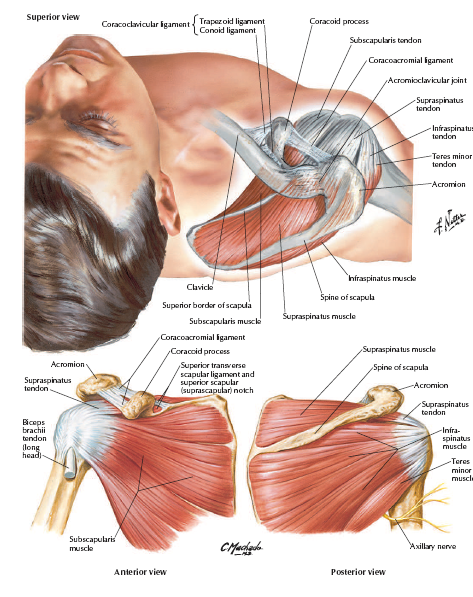
ANATOMY AND FUNCTION
The shoulder joint is a ball and socket joint that connects the bone of the upper arm (humerus) with the shoulder blade (scapula). The capsule is a broad ligament that surrounds and stabilizes the joint. The shoulder joint is moved and also stabilized by the rotator cuff. The rotator cuff is comprised of four muscles and their tendons that attach from the scapula to the humerus. The rotator cuff tendons (supraspinatus, infraspinatus, teres minor) and are just outside the shoulder joint and its capsule. The muscles of the rotator cuff help stabilize the shoulder and enable you to lift your arm, reach overhead, and take part in activities such as throwing, swimming and tennis.
' ROTATOR CUFF INJURY AND TREATMENT OPTIONS
The rotator cuff can tear as an acute injury such as when lifting a heavy weight or falling on the shoulder or elbow. The shoulder is immediately weak and there is pain when trying to lift the arm. A torn rotator cuff due to an injury is usually best treated by immediate surgical repair. The rotator cuff can also wear out as a result of degenerative changes. This type of rotator cuff tear can usually be repaired but sometimes the tear may not need to be repaired and sometimes cannot be repaired. However, if the tear is causing significant pain and disability, surgery may be the best treatment to relieve pain and improve shoulder function. If a tom rotator cuff is not repaired, the shoulder often develops degenerative changes and arthritis many years later. This type of arthritis is very difficult to treat and the longstanding tear in the rotator cuff may be irreparable.
DIAGNOSIS OF TORN ROTATOR CUFF Symptoms of shoulder pain that awaken you at night, and weakness raising the arm are suggestive of a torn rotator cuff. Examination of the shoulder usually reveals weakness. The diagnosis can be confirmed by magnetic resonance imaging (MRI) or an x-ray taken after dye has been injected into the shoulder (arthrogram). A more sensitive test such as arthrogram MRI or arthroscopy may be needed to diagnose a small tear or a partial tear of the rotator cuff.
ROTATOR CUFF REPAIR Most rotator cuff tears can be repaired surgically by reattaching the torn tendon(s) to the humerus. It is not a big operation to repair a torn rotator cuff, but the rehabilitation time can be long depending on the size of the tear and the quality of the tendons/muscles. The deltoid muscle is separated to expose the torn rotator cuff tendon(s). Sutures are attached to the torn tendons. Tiny holes are made in the humerus where the tendons were attached and the sutures are passed through the bone and tied, securing the rotator cuff tendons back to the humerus. Sometimes, suture anchors are used as well. The tendons heal back to the bone, reestablishing the normal tendon-to-bone connection. It takes several months for the tendon to heal back to the bone. During this time, forceful use of the shoulder such as weight lifting and raising the arm out to the side or overhead must be avoided. After surgery, you will probably use a sling for 4 to 6 weeks. You can remove the sling 4 to 5 times a day for gentle pendulum motion exercises. Rarely, a large pillow that holds your arm out to the side of your body is needed for 6 weeks if the tear is very large or difficult to repair.
RESULTS OF SURGERY AND RISKS The success of surgery to repair the rotator cuff depends upon the size of the tear and how long ago the tear occurred.. Usually, a small tear has a good chance for full recovery. If the tear is large, the extent of recovery cannot be accurately predicted until the repair and rehabilitation is completed. If the tear occurred a long time ago (several months or longer) it can be difficult or sometimes impossible to repair. Most patients achieve good pain relief following repair regardless of the size of the tear unless the tear is massive. Shoulder pain is usually worse than before surgery the first 3 to 4 weeks or even several months after surgery, but then gradually the pain lessens. This is especially true while trying to sleep at night. It can take up to a full year to regain motion and function in the shoulder. Shoulder stiffness and loss of motion are potential problems after rotator cuff repair. Re-rupture of the repaired rotator cuff is possible if too much force is placed on the repaired tendon before it is fully healed. Nerve and muscle injury and infection are infrequent complications.
